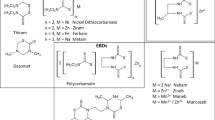Abstract
A method was validated for the estimation of dithiocarbamates in soybean leaf, pod, seed, oil and in soil. Method involves acid hydrolysis and reduction of dithiocarbamates to carbon disulfide in the presence of stannous chloride and hydrochloric acid. Thiram was spiked in the samples at the levels of 0.5, 2.5 and 5.0 µg g−1 and estimated as carbon disulfide on gas chromatograph coupled to single quadrupole (GC–MS) by monitoring m/z 76 (quantitation ion). Retention time of carbon disulfide was 2.119. All method validation parameters like linearity, accuracy and precision were within the acceptable range as per SANTE (in European Union Guidance document on analytical quality control and method validation procedures for pesticide residues analysis in food and feed. Document No. SANTE/11945/2015, 2015). The linearity, expressed as correlation coefficient, was 0.997. Accuracy was expressed as percent recovery. The recovery ranged from 87 to 102% in soybean leaf, 81–98% in soybean pod, 83–113% in soybean seed, 85–109% in soybean oil and 75–109% in soil at different fortification levels. Precision, expressed as relative standard deviation, ranged from 0.1 to 0.11 in various soybean samples. Limit of quantitation (LOQ) was 0.32 µg g−1 for soybean leaf, 0.18 µg g−1 for pod, 0.19 µg g−1 for seed and 0.1 µg g−1 for oil and soil. To our knowledge, this is the first report describing the extraction and analysis of thiram, a dithiocarbamate (DTCs) from soybean (oilseeds and oil). The method described here can be extended for the estimation of DTCs in other oilseeds and oils.


Similar content being viewed by others
References
AOAC (2016) AOAC-Official methods of analysis of AOAC International. In: Latimier GW Jr. (ed) 20th edn
Cajka T, Riddellova K, Zomer P, Mol H, Hajslova J (2011) Direct analysis of dithiocarbamate fungicides in fruits by ambient mass spectrometry. Food Add Contam 28(10):1372–1382
Caldas ED, Conciecao MH, Miranda MCC, de Souza LCKR, Lima JF (2001) Determination of dithiocarbamate fungicide residues in food by a spectrophotometric method using a vertical disulfide reaction system. J Agric Food Chem 49(10):4521–4525
Crnogorac G, Schwack W (2009) Residue analysis of dithiocarbamate fungicides. Trends Anal Chem 28(1):40–50
Dasgupta S, Mujawar S, Banerjee K, Huebschmann H (2012) Analysis of dithiocarbamate pesticides by GC–MS. Thermo-Fischer Application Note 10333
Ekroth SB, Ohlin B, Osterdahl BG (1998) Rapid and simple method for determination of thiram in fruits and vegetables with high-performance liquid chromatography with ultraviolet detection. J Agric Food Chem 46(12):5302–5304
Hadi S (1995) Dithiocarbamate residues in soils and crops from garlic-growing areas of Lombok, Indonesia, Master of Science (Hons.) thesis, Department of Chemistry, University of Wollongong. http://ro.uow.edu.au/theses/2781
Juliatti FC, de Azevedo LAS, Juliatti FC (2017) Strategies of chemical protection for controlling soybean rust, soybean—the basis of yield, biomass and productivity. In: Kasai M (ed). InTech. https://doi.org/10.5772/67454. https://www.intechopen.com/books/soybean-the-basis-of-yield-biomass-and-productivity/strategies-of-chemical-protection-for-controlling-soybean-rust
Kaur M, Kaur V, Malik AK, Verma N, Singh B, Rao ALJ (2009) Development of a derivative spectrophotometric method for the determination of fungicide zinc ethylenebisdithiocarbamate using sodium molybdate. J Braz Chem 20(5):993–998. https://doi.org/10.1590/S0103-50532009000500026
Kavatsurwa SM, Kiremire B, Wasswa J, Mpiana PT (2014) Dithiocarbamates residues level in selected egetables from Bukavu, Democratic Republic of Congo. J Phys Chem Sci 3:1–7
Kundu C, Goon A, Bhattacharya A (2012) Persistence behaviour of fungicidemixture (benalaxyl-M 4% + mancozeb 65%) WP in grapes. Bull Environ Contam Toxicol 89:1253–1257
Liu S, Bai A, Zhou L, Yu C, Li Y, Fan S, Pan C (2015) Dissipation and residues of thiram in potato and soil. J Chem, Article ID 623847. http://dx.doi.org/10.1155/2015/623847
Malik AK, Rao ALJ (1990) Spectrophotometric determination of some dithiocarbamates. Talanta 37(12):1205–1207
Mohapatra S, Deepa M (2012) Residue dynamics of fenamidone and mancozeb on gherkin under two agro climatic zones in the state of Karnataka, India. Bull Environ Contam Toxicol 88:507. https://doi.org/10.1007/s00128-012-0558-2
Mujawar S, Utture S, Fonesca E, Matarria J, Banerjee K (2014) Validation of a GC-MS method for the estimation of dithiocarbamate fungicide residue and safety evaluation of mancozeb in fruits and vegetables. Food Chem 150:175–181
Nakamura M, Noda S, Kosugi M, Ishiduka N, Mizukoshi K, Taniguchi M, Nemoto S (2010) Determination of dithiocarbamates and milneb residues in foods by gas chromatography-mass spectrometry. Shokuhin Eiseigaku Zasshi 51(5):213–219
Patsakos PG, Liapis K, Miliadis GE, Zafiriou K (1992) Mancozeb residues on field sprayed apricots Bull. Environ Contam Toxicol 48:756. https://doi.org/10.1007/BF00195998
Pesticide Analytical Methods (1999) In: McMahon BM (ed) vol 1, 3rd edn. U.S. Department of Health and Human Services, Public Health Service Food and Drug Administration
Rai JK, Keshavayya J, Rai SK (2012) A new method for the estimation of dithiocarbamates using vapodest. Int J ChemTechnol Res 4(3):867–869
Rani R, Sharma VK, Rattan GS, Singh B, Sharma N (2013) Dissipation of residues of mancozeb and metalaxyl in tomato (Solanum lycopersicum L.). Bull Environ Contam Toxicol 90:248. https://doi.org/10.1007/s00128-012-0910-6
Reynold S (2006) Analysis of dithiocarbamates. SELAMAT workshop 5–7 July 2006, Bangkok
SANTE (2015) European Union Guidance document on analytical quality control and method validation procedures for pesticide residues analysis in food and feed. Document No. SANTE/11945/2015
Schmidt B, Christensen HB, Petersen A, Sloth JJ, Poulsen ME (2013) Method validation and analysis of nine dithiocarbamates in fruits and vegetables. Food Addit Contam Part A 30(7):1287–1298
Acknowledgements
Authors acknowledge the support from Department of Agriculture and Cooperation, Government of India, for financial support.
Author information
Authors and Affiliations
Corresponding author
Ethics declarations
Conflict of interest
Authors declare that they have no conflict of interest.
Additional information
Editorial responsibility: M. Abbaspour.
Rights and permissions
About this article
Cite this article
Chawla, S., Patel, H.K., Kalasariya, R.L. et al. Validation and analysis of thiram, a dithiocarbamate, as CS2 from soybean (Glycine max) samples on GC–MS. Int. J. Environ. Sci. Technol. 16, 6991–6998 (2019). https://doi.org/10.1007/s13762-018-2069-0
Received:
Revised:
Accepted:
Published:
Issue Date:
DOI: https://doi.org/10.1007/s13762-018-2069-0




